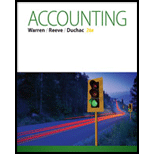
Concept explainers
Classification of accounts
Asset: Assets refer to the resources owned by the business, which are utilized in the course of the business to generate revenue. The following belong to the assets account:
Accounts Receivable - Prepaid
- Cash
- Land
- Supplies
Liability: Liabilities include the claims of the creditors on the assets of the business. The liability is the obligation of the business. The following belong to the liabilities account:
- Accounts Payable
- Salaries payable
- Notes payable
- Income tax payable
- Unearned rent
Revenue: Revenue is known as “Top line” because it appears very top on the income statement of the company. It is used to imply profits or net income (bottom line) of the company by subtracting the total expenses from total revenues. The following belong to the revenue account
- Rent revenue
- Fees earned
- Service revenue
Expense: Expense is the cost borne by a company to produce and sell the goods and services to the customers. The following belong to the expense account
- Salaries expense
- Insurance expense
- Supplies expense
- Utilities expense
Depreciation expense
To Identify: Each account would appear as (a) assets, (b) liabilities, (c) revenue or (d) expense.
Want to see the full answer?
Check out a sample textbook solution
Chapter 4 Solutions
ACCOUNTING,CHAP.1-13
- Jensen Corp.'s $5 par value common stock is actively traded at a market value of $12 per share. Jensen issues 8,000 shares to purchase land advertised for sale at $105,000. Journalize the issuance of the stock in acquiring the land. Helparrow_forwardHamilton Manufacturing sells a single product. Its annual revenue is $1,500,000, and its profit is $75,000. Fixed costs amount to $325,000. Compute Hamilton's operating leverage.arrow_forwardWhat is the price earnings ratio of this financial accounting question?arrow_forward
- Please need answer the financial accounting questionarrow_forwardJensen Corp.'s $5 par value common stock is actively traded at a market value of $12 per share. Jensen issues 8,000 shares to purchase land advertised for sale at $105,000. Journalize the issuance of the stock in acquiring the land.arrow_forwardHello tutor please provide this question solution general accountingarrow_forward
- Please give me answer accountingarrow_forward4. Galindo Long-Haul, Inc., is considering the purchase of a tractor-trailer that would cost $178,848, would have a useful life of 8 years, and would have no salvage value. The tractor- trailer would be used in the company's hauling business, resulting in additional net cash inflows of $36,000 per year. Galindo Long-Haul, Inc. has a cost of capital of 9%. What is the internal rate of return on the investment in the tractor-trailer? And is the investment acceptable for the company?arrow_forwardSolve this Financial Accounting Problemarrow_forward
- Kendrick Manufacturing Corp. (KMC) has total assets of $600 million, $80 million of which are cash. It has total debt of $250 million. If KMC repurchases $30 million of its stock, what changes will occur on its balance sheet? What will its new leverage ratio be? Helparrow_forwardXYZ CORPORATION, WHICH APPLIES MANUFACTURING OVERHEAD ON THE BASIS OF MACHINE HOURS, HAS PROVIDED THE FOLLOWING DATA FOR ITS MOST RECENT YEAR OF OPERATIONS: ESTIMATED MANUFACTURING OVERHEAD = $420,000 •. • ESTIMATED MACHINE HOURS = 10,000 ACTUAL MANUFACTURING OVERHEAD = $425,000 ACTUAL MACHINE HOURS = 10,200 THE ESTIMATES WERE MADE AT THE BEGINNING OF THE YEAR TO COMPUTE THE PREDETERMINED OVERHEAD RATE. COMPUTE THE PREDETERMINED OVERHEAD RATE.arrow_forwardCan you please solve this financial accounting question?arrow_forward
- Principles of Accounting Volume 1AccountingISBN:9781947172685Author:OpenStaxPublisher:OpenStax CollegeCentury 21 Accounting Multicolumn JournalAccountingISBN:9781337679503Author:GilbertsonPublisher:Cengage
 College Accounting (Book Only): A Career ApproachAccountingISBN:9781337280570Author:Scott, Cathy J.Publisher:South-Western College Pub
College Accounting (Book Only): A Career ApproachAccountingISBN:9781337280570Author:Scott, Cathy J.Publisher:South-Western College Pub Auditing: A Risk Based-Approach to Conducting a Q...AccountingISBN:9781305080577Author:Karla M Johnstone, Audrey A. Gramling, Larry E. RittenbergPublisher:South-Western College Pub
Auditing: A Risk Based-Approach to Conducting a Q...AccountingISBN:9781305080577Author:Karla M Johnstone, Audrey A. Gramling, Larry E. RittenbergPublisher:South-Western College Pub Financial And Managerial AccountingAccountingISBN:9781337902663Author:WARREN, Carl S.Publisher:Cengage Learning,
Financial And Managerial AccountingAccountingISBN:9781337902663Author:WARREN, Carl S.Publisher:Cengage Learning,





